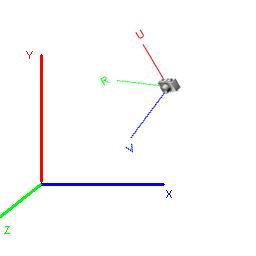For those of you who *have* used gluLookAt, it is analogous to a target camera in MAX. I mean, you tell where it is supposed to be, which co ordinates to look at, and you're all set. gluLookAt, by the way accomplishes this using a set of glRotatef's and glTranslatef's. I have found it better to construct the entire matrix on my own, and glMatrixMult it at one go.
I will now briefly cover the camera model we are going to use. The working model that I implemented for my engine was from a splendid tutorial by Tom Nuydens of Delphi3D. It's called the RUV model (thats what I call it, anyway). If we were to use a translation, and X,Y,Z rotation to represent the camera, we would suffer from the problem of gimbal lock (it is really exasperating to code a lot and then discover you were wrong to start with). I am not going to go into what gimbal lock is, or anything. You can find a lot of atricles on it. This camera overcomes this drawback, and that should be good enough.

//Base camera class to derive custom cameras from
TCamera=class
private
fName:shortstring;
fViewVolume:TViewVolume;
public
constructor Create;
procedure SetView;virtual;
property Name:shortstring
read fName
write fName;
property ViewVolume:TViewVolume
read fViewVolume
write fViewVolume;
end;
TRUVCamera=class(TCamera)
private
fViewpoint:TVector;
fR:TVector;
fU:TVector;
fV:TVector;
protected
public
constructor Create;
property R:TVector
read fR
write fR;
property U:TVector
read fU
write fU;
property V:TVector
read fV
write fV;
public
procedure RotateAboutR(amt:TFloat);
procedure RotateAboutU(amt:TFloat);
procedure RotateAboutV(amt:TFloat);
function GetView:TMatrix;virtual;
procedure SetView;override;
property Viewpoint:TVector
read fViewpoint
write fViewpoint;
end;
procedure TRUVCamera.RotateAboutR(amt:TFloat);
begin
fR:=VectorRotateX(fR,amt);
fU:=VectorRotateX(fU,amt);
fV:=VectorRotateX(fV,amt);
fR:=VectorNormalize(fR);
fU:=VectorNormalize(fU);
fV:=VectorNormalize(fV);
end;
function VectorRotateX(v:TVector;a:TFloat):TVector;
var
temp: TVector;
sine,cosine:TFloat;
begin
a:=a*DEGTORAD;
sine:=Sin(a);
cosine:=Cos(a); temp[X] := v[x];
temp[Y]:= (v[Y] * cosine) + (v[Z] * -sine);
temp[Z] := (v[Y] * sine) + (v[Z] * cosine);
result := temp;
end;function VectorNormalize(v:TVector):TVector;
var
val:TFloat;
begin
val:=v[x]*v[x]+
v[y]*v[y]+
v[z]*v[z];
val:=sqrt(val);
result[x]:=v[x]/val;
result[y]:=v[y]/val;
result[z]:=v[z]/val;
end;
function TRUVCamera.GetView:TMatrix;
var
rotMatrix,transMatrix:TMatrix;
begin
transMatrix:=GetIdentity;
transMatrix[0,3]:=fViewpoint[0];
transMatrix[1,3]:=fViewpoint[1];
transMatrix[2,3]:=fViewpoint[2]; rotMatrix:=GetIdentity; rotMatrix[0,0]:=fR[0];
rotMatrix[1,0]:=fR[1];
rotMatrix[2,0]:=fR[2]; rotMatrix[0,1]:=fU[0];
rotMatrix[1,1]:=fU[1];
rotMatrix[2,1]:=fU[2]; rotMatrix[0,2]:=fV[0];
rotMatrix[1,2]:=fV[1];
rotMatrix[2,2]:=fV[2]; result:=MatrixMultiply(transMatrix,rotMatrix);
end;
procedure TRUVCamera.SetView;
var
view:TMatrix;
begin
inherited;
view:=GetView;
view:=MatrixTranspose(view);
glMatrixMode(GL_MODELVIEW);
glLoadIdentity;
glMultMatrixf(@view[0,0]);
end;
SetView internally calls the function GetView, which returns a matrix. GetView constructs the view matrix in three steps.
- It first makes the translation happen by loading the appropriate values in the Identity matrix.
- It then loads the appropriate values of the axes R,U,V into another matrix.
- It finally returns the product of the two matrices as the result.
You'll also need, in case you dont have them already
>>Download the OpenGL 1.2 headers